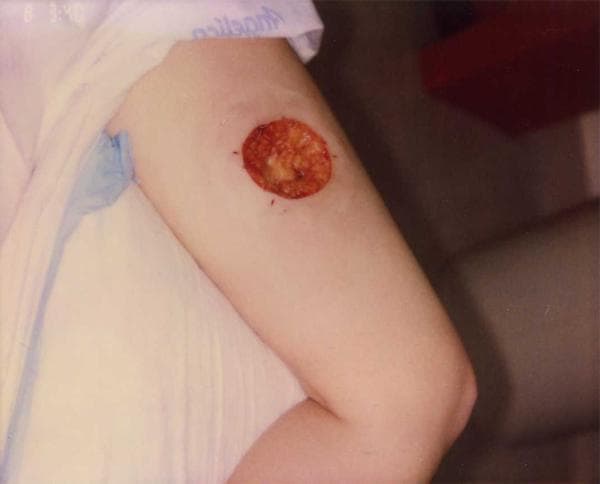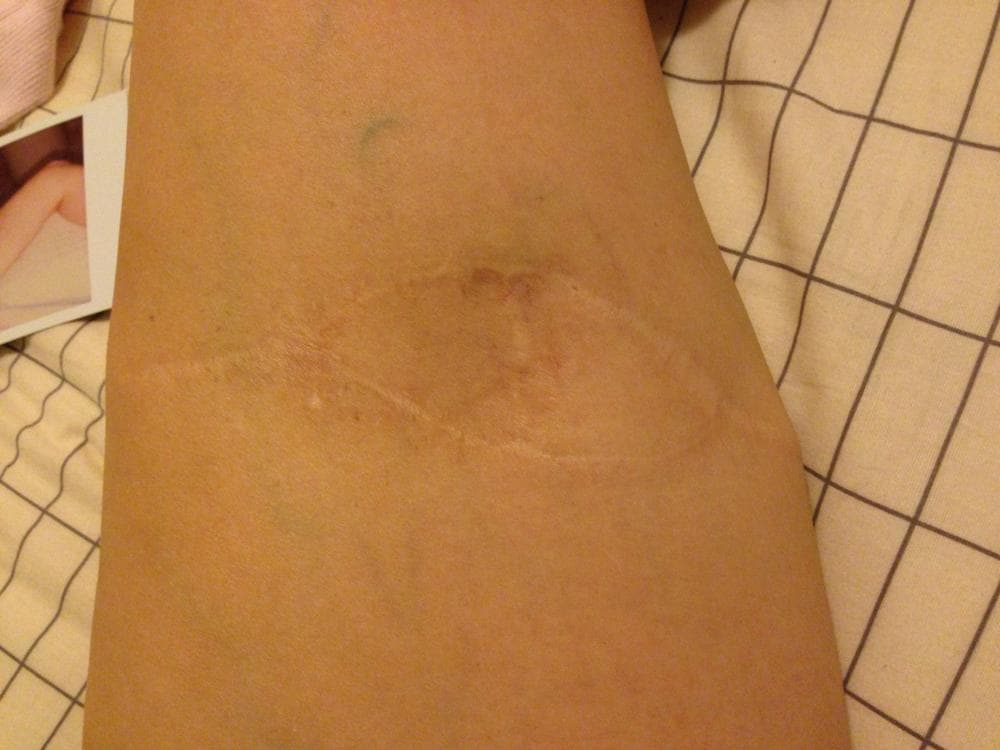Advertisement
When A Patient Asks, 'Why Won't Anybody Just Talk To Me?'

By Alicair Peltonen
Guest contributor
I watched in fascination as the dermatologic surgeon closed up a hole the size of a baseball in my thigh.
Suddenly, a jolt of pain like nothing I had ever felt before shot through my entire body. My vision tunneled and twirled like a party-favor kaleidoscope. The last thing I remember clearly is crying to my nurse that I was sorry I couldn’t be stronger for her.
I was quickly given Ativan and a painkiller. When the medical team had stitched up my leg and I was coming out of my haze, they handed me to my husband, along with some wound-care instructions and prescriptions, and I went home.
On my couch and in considerable pain, I thought, “What the hell happened in there?”
That surgery that seemed to go awry was way back in 2007, but only recently did I put that question to my surgeon, as I tried to understand both my medical care and my reaction to it. I come away convinced that the operation itself didn’t go wrong — but the doctor-patient communication surrounding it did.

Again and again over the course of months, I felt too intimidated to ask the questions echoing in my mind. Nor did my health care team initiate the conversations I desperately needed. That disconnect is a towering problem in American health care, some experts say,
Poor patient-doctor communication, says Harvard School of Public Health professor and former pediatric surgeon Lucian Leape, is "probably the single greatest source of missed information that leads to erroneous treatment, treatment not followed properly, unnecessary anxiety.”
Also, I can attest, it can lead to doubts that may fester for many years.
It began with a blemish
In 1999, while I was living with my parents in Maryland, I noticed that a blemish on my left thigh was not going away. The dermatologist I saw told me it was probably a benign fibroma. It could be removed for cosmetic purposes or left alone with no detrimental effects. I figured my COBRA insurance wouldn’t cover anything cosmetic, so I chose the latter.
Eventually I moved to Boston, got married, and landed a very stable job. The growth on my leg hadn’t changed in size or shape, but I decided to brandish my shiny new quality medical insurance and get rid of it. In November of 2007, I showed up for a routine fibroma excision.
Two weeks later, I was alone in my office at 6:30 p.m. when the phone rang. It was the dermatology department. I was told that the growth was not a benign fibroma, but rather a rare malignancy called Dermatofibrosarcoma Protuberans, or DFSP. They had already scheduled me to return to the office in a week for a surgical procedure. Did I have any questions? The conversation went something like this:
“So…I have cancer?”
“Yes. It’s a rare form, but very treatable,” said the nurse.
“So….wait…do I need chemo or radiation or anything?” I asked.
“No, just the surgery. Do you want to schedule a phone call with the doctor to ask questions?”
“Yes. Definitely.”
I remember thinking, “Should that conversation have happened over the phone? With a nurse?”
The next day, after extensive poking around on the Internet, I spoke to the dermatologic surgeon. I asked if they would follow the standard procedure of performing the surgery in the office, and whether they would leave the wound open for a number of days during extensive testing. The answer to both questions was yes. That was about the extent of the phone call. And again, I thought “Do they really just talk to people about their cancer treatment over the phone now?”
‘You’re sending me home like this?’
The next week, under local anesthesia, I watched as the cancer was cut out of my leg.
The surgeon removed a golf ball-sized piece of tissue in a circle around the original excision site. That piece of tissue was taken to another room, flash frozen, and sliced into very thin sections to be analyzed microscopically. A “map” was created of the wound and the location of the finger-like tendrils of cancer that were growing toward my bone.
The surgeon then laid the map over the wound and took more tissue. This time only the cancerous area was removed, leaving the healthy remainder in the hole intact. This procedure continued a couple more times, until they couldn’t find any more cancer to remove. I found it riveting.
I was left with a gaping hole in my leg. The surgeon estimated that about 15% of my left thigh was gone. The hole was then packed with antibiotic-soaked gauze and my leg wrapped with pressure bandages. It was at this point that I remember thinking very clearly, “Wait, you’re still planning on sending me home like this?”
But I didn't ask it out loud. I was given a prescription for pain medication and told that testing could take up to seven days. The nurse gave me printed instructions on wound care and told me I couldn’t get my leg wet. She said they’d call me when I could come back to either be closed up or have more tissue removed.
This was the first of multiple instances in which there was a conversation that I now think needed to happen, but didn’t.
The wound on my leg seemed pretty severe and even with an attentive husband, strong pain-killers, and the occasional can of Pabst to supplement, I was in considerable pain. I couldn’t shower; going to the bathroom was a challenge. Through the fog of Percocet, I thought “Should I really be left to care for myself in this condition and for this long?”
Five days after my surgery, I arrived at the doctor’s office with my bandages intact and not smelling my best. The testing had come back negative and I was cancer-free. The only thing left to do was watch them close up that hole and make up a good story about the giant scar.
Then the pain hit
After only a few days, the tissue inside my wound had been exposed to the outside environment enough to require sterilization before being closed up. To accomplish this, the surgeon needed to perform a fair amount of debriding, or "roughing up" of the inside of the wound to clean out the wound and aid in the healing process. In addition, any blood or lymph vessels that opened into the hole needed to be cauterized to prevent drainage.
Suffice it to say, it was unpleasant, but again, was done in the examination room with local anesthetic. And again, I found it fascinating to watch.
Then the pain hit.
Here again, another conversation was necessary. I was never told exactly what happened in that examination room. I assumed the pain jolt came from a nerve being hit during the debridement process.
As I understand it, the cavity in my leg was too large to close in a straight line, as had been the plan. In the end, the surgeon used triangular skin grafts from just outside the hole to create a “lid” over the deepest part. The pain would eventually subside and the scar looked very cool, but I couldn’t help thinking, “Did my surgeon get in over his head? Should he have consulted with anyone before closing me up?”

In January of 2008, I was back at my job with my fresh scar and a slight limp. Things should have ended there. But it would be six months and a hospitalization before my leg would be back to normal.
Shortly after I went back to work, the area underneath the scar swelled and became rock-hard. I went back to the surgeon and a tray full of clear liquid was drained from my leg. I was told it was most likely lymphatic fluid. By June I’d seen the surgeon four times for the same draining procedure, and by the beginning of July, I had developed an infection and spiked a fever.
But why did this happen?
I spent three days in a hospital room. During that time, there were at least three different doctors in to see me, including my surgeon, who stopped in to check on me. They all told me that my leg was looking better and that the fever and infection seemed to be slowly subsiding. Good news, but I remember thinking, “But why did this happen and how are you planning to stop it? Why won’t anybody just talk to me?”
When I was released, my leg was infection-free and the swelling had gone down. I have since followed up with a number of different dermatologists to be sure the cancer doesn’t return. It hasn’t.
Overall, I feel incredibly lucky. I had a ticking time bomb in my leg and it was defused and removed by a caring and competent group of people.
But five years later I’m still haunted by conversations I didn’t have. If I had been admitted to the hospital while my wound was open, would I have been in less pain? If another surgeon had been consulted, would the closing process have gone more smoothly? Could a vascular surgeon have prevented the lymphatic fluid drainage issue?
Engaging the patient in their own care requires conversations about diagnoses, treatments and possible outcomes, says Lucian Leape of Harvard. This isn’t always easy. It takes time, and requires physicians to give up some control and allow patients to direct their own care.
“Informed decision-making is the most obvious place where there’s a real need for improvement in patient engagement,” Leape said. “Categorically, we do a crappy job of it.”
The evidence is overwhelming, he said, that an informed patient, who is consulted on their own care, makes different decisions than a passive patient. “And, the presumption is those are the more appropriate decisions because they’re the ones that fit with [the patient’s] values,” he said. “They have fewer procedures; that is, they’re more likely to opt for non-surgical or non-invasive things.”
I’m a chatty person. I am curious, I love to ask questions and I have no filter whatsoever. And when I’m in a doctor’s office, I lose any and all physical modesty. But apparently, my brain adopts heightened security. What is it about a paper medical gown that makes me, and so many other patients, clam up?
Mocha with my surgeon
Unlike most patients, I recently got a chance to speak at length with my surgeon about what happened. In a coffee shop, in civilian clothes and drinking mochas, we sat and talked as people. My surgeon seemed just as confused as I was. “What could have been better explained? What might have been done differently to put me at ease?”
I concluded that my self-inflicted lockjaw was rooted in fear. I asked some technical questions, then clammed up when it came to questions that might challenge my surgeon’s decisions. But those weren’t the questions I really wanted to ask anyway. In the process of sipping coffee and chatting, I realized that what I had really wanted to know was “Am I going to be in a lot of pain?” and “Will this cancer come back?”
Had I asked those questions back then, the honest answers would have been “Yes” and “I don’t know.”
On our last sips of coffee, the conversation went a bit like this: My surgeon said, “What could I have asked that might have gotten you talking about those questions?”
“I don’t know,” I said. “Maybe something like ‘What are your greatest fears going forward…what are you afraid of?”
“See, those might not be great words to use…fears…afraid. Patients might then think they have something to be afraid of. That might actually make them more afraid. What about something like ‘What are your concerns going forward?”
“Yeah, but isn’t that too easy a question to dodge?” I asked. “I mean, concerns sounds technical so I could easily start asking technical questions again, right?”
I started to get frustrated. If you are about to be cut open, it seems to me that “fear” and “afraid” are going to be pretty common words floating in your head, and maybe that common vocabulary is needed to coax a patient out of their self-created muzzle.
Then it hit me: Despite the mental pedestals we put them on, doctors are just people. They wear cargo shorts and running T-shirts and they drink mochas, and they are afraid too.
Nobody likes to tell someone that it’s going to hurt. Nobody wants to admit they don’t know something.
Conversation deficit disorder
Jo Shapiro, director of the Center for Professionalism and Peer Support (CPPS) at Brigham and Women’s Hospital, calls this "conversation deficit disorder:” To avoid emotional questions with blunt and sometimes unsatisfying answers, doctors often prefer to stick to technical information.
“They just failed to have the series of conversations you needed,” she said, in a recent interview.
Dr. Shapiro believes that the key to improving doctor-patient communication is peer support for the clinicians. “If you don’t support the clinician, then that clinician can’t really be present in that compassionate, transparent way,” she said.
At Brigham and Women’s Hospital, Dr. Shapiro's center is part of a pilot program that aims to make sure colleagues are available to talk when a doctor faces a difficult conversation with a patient. “We’ve got to support each other in the medical community so that, as clinicians, we can support the patient. We have to do right by the patient, even in a society that doesn’t do right by us,” she said.
That's from the doctor's point of view. So how can we patients get more comfortable in a doctor’s office? How can we shake off the fear of what a doctor might say, and ask what we really want to know?
“Practice,” says Dr. Zackary Berger, an internist at Johns Hopkins Outpatient Center and author of the recently published "Talking to Your Doctor: A Patient’s Guide to Communication in the Exam Room and Beyond."
One suggestion for a visit to a primary care doctor, Dr. Berger said in an email, is to “frame symptoms in a narrative," a coherent story that is easy to understand and “can elicit sympathy (which matters for doctors, like everyone else.)”
Dr. Berger says the doctor-patient relationship is like any relationship. It requires work. “Emotions play a huge and unrecognized role in the visit,” he wrote. “Physicians (and nurses) have emotions, too. Recognizing your own emotions, and how they interact with your doctor’s, can help avoid misunderstandings.”
So essentially, in my surgeon’s office, five years ago, you had two people who were happy to have a conversation, but scared to initiate it. And I imagine that’s the situation in doctors’ offices all over the country.
When I go to a doctor’s appointment now — any doctor’s appointment — I try to picture a paper gown on my brain, as well as my body. When the doctor says, “Okay, let’s drop that and take a look,” they both have to come down.
Readers, reactions? Have you experienced difficult patient-doctor communication and its effects?
Alicair Peltonen is a part-time administrative assistant at the Harvard School of Public Health and a journalism student at the Harvard Extension School.